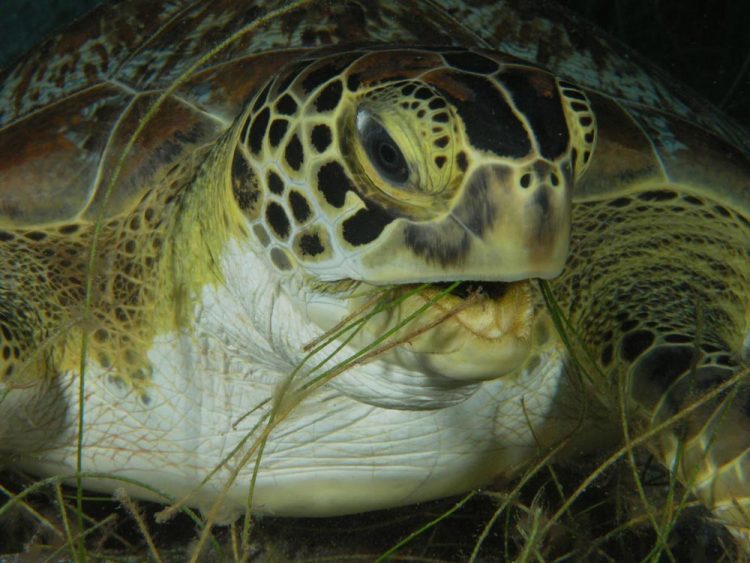Extensive seagrass meadows discovered in Indian Ocean through satellite tracking of green turtles

This is a green turtle with seagrass in the Caribbean. Credit: Swansea University
A new study by Swansea University and Deakin University academics, published in the recent Marine Pollution Bulletin, reported how the monitoring of the turtles — which forage on seagrasses – tracked the species to the Great Chagos Bank, the world's largest contiguous atoll structure in the Western Indian Ocean.
This area lies in the heart of one of the world's largest Marine Protected Areas (MPAs) and the study involved the use of in-situ SCUBA and baited video surveys to investigate the day-time sites occupied by the turtles, resulting in the discovery of extensive monospecific seagrass meadows of Thalassondendron ciliatum.
These habitats are critically important for storing huge amounts of carbon in their sediments and for supporting fish populations.
At three sites that extended over 128?km of the Great Chagos Bank, there was a high seagrass cover (average of 74%) at depths to 29 metres.
The mean species richness of fish in the seagrass meadows was 11 species per site, with a mean average of 8-14 species across the aforementioned three sites.
Results showed a high fish abundance as well as a large predatory shark recorded at all sites and given that the Great Chagos Bank extends over approximately 12,500?km and many other large deep submerged banks exist across the world's oceans, the results suggest that deep-water seagrass may be far more abundant than previously suspected.
Reports of seagrass meadows at these depths with high fish diversity, dominated by large top predators, are relatively limited.
Dr Nicole Esteban, a Research Fellow at Swansea University's Biosciences department, said: “Our study demonstrates how tracking marine megafauna can play a useful role to help identify previously unknown seagrass habitat.
“We hope to identify further areas of critical seagrass habitat in the Indian Ocean with forthcoming turtle satellite tracking research.”
Dr Richard Unsworth, from Swansea University's Biosciences department, said: “Seagrasses struggle to live in deep waters due to their need for high light, but in these crystal clear waters of Chagos these habitats are booming.
“Given how these habitats are threatened around the world it's great to come across a pristine example of what seagrass meadows should look like.”
###
This research was led by the Bioscience department at Swansea University, alongside the involvement of researchers at Deakin University.
Media Contact
All latest news from the category: Life Sciences and Chemistry
Articles and reports from the Life Sciences and chemistry area deal with applied and basic research into modern biology, chemistry and human medicine.
Valuable information can be found on a range of life sciences fields including bacteriology, biochemistry, bionics, bioinformatics, biophysics, biotechnology, genetics, geobotany, human biology, marine biology, microbiology, molecular biology, cellular biology, zoology, bioinorganic chemistry, microchemistry and environmental chemistry.
Newest articles

A ‘language’ for ML models to predict nanopore properties
A large number of 2D materials like graphene can have nanopores – small holes formed by missing atoms through which foreign substances can pass. The properties of these nanopores dictate many…

Clinically validated, wearable ultrasound patch
… for continuous blood pressure monitoring. A team of researchers at the University of California San Diego has developed a new and improved wearable ultrasound patch for continuous and noninvasive…

A new puzzle piece for string theory research
Dr. Ksenia Fedosova from the Cluster of Excellence Mathematics Münster, along with an international research team, has proven a conjecture in string theory that physicists had proposed regarding certain equations….



